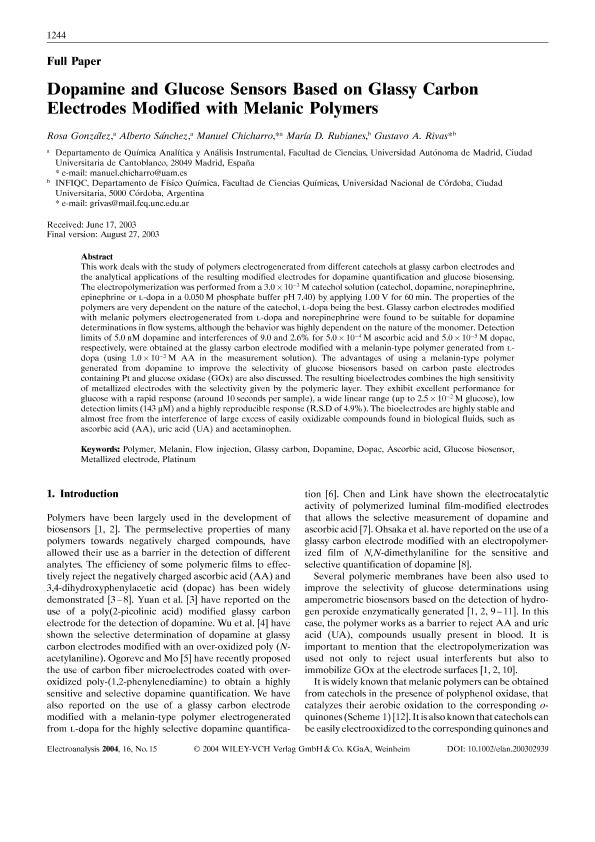Mostrar el registro sencillo del ítem
dc.contributor.author
González, Rosa
dc.contributor.author
Sánchez, Alberto
dc.contributor.author
Chicharro, Manuel
dc.contributor.author
Rubianes, María Dolores

dc.contributor.author
Rivas, Gustavo Adolfo

dc.date.available
2018-02-21T19:39:45Z
dc.date.issued
2004-08
dc.identifier.citation
González, Rosa; Sánchez, Alberto; Chicharro, Manuel; Rubianes, María Dolores; Rivas, Gustavo Adolfo; Dopamine and glucose sensors based on glassy carbon electrodes modified with melanic polymers; Wiley VCH Verlag; Electroanalysis; 16; 15; 8-2004; 1244-1253
dc.identifier.issn
1040-0397
dc.identifier.uri
http://hdl.handle.net/11336/36890
dc.description.abstract
This work deals with the study of polymers electrogenerated from different catechols at glassy carbon electrodes and the analytical applications of the resulting modified electrodes for dopamine quantification and glucose biosensing. The electropolymerization was performed from a 3.0 × 10 -3 M catechol solution (catechol, dopamine, norepinephrine, epinephrine or L-dopa in a 0.050 M phosphate buffer pH 7.40) by applying 1.00 V for 60 min. The properties of the polymers are very dependent on the nature of the catechol, L-dopa being the best. Glassy carbon electrodes modified with melanic polymers electrogenerated from L-dopa and norepinephrine were found to be suitable for dopamine determinations in flow systems, although the behavior was highly dependent on the nature of the monomer. Detection limits of 5.0 nM dopamine and interferences of 9.0 and 2.6% for 5.0 × 10-4 M ascorbic acid and 5.0 × 10-5 M dopac, respectively, were obtained at the glassy carbon electrode modified with a melanin-type polymer generated from L-dopa (using 1.0 × 10-3 M AA in the measurement solution). The advantages of using a melanin-type polymer generated from dopamine to improve the selectivity of glucose biosensors based on carbon paste electrodes containing Pt and glucose oxidase (GOx) are also discussed. The resulting bioelectrodes combines the high sensitivity of metallized electrodes with the selectivity given by the polymeric layer. They exhibit excellent performance for glucose with a rapid response (around 10 seconds per sample), a wide linear range (up to 2.5 × 10-2 M glucose), low detection limits (143 μM) and a highly reproducible response (R.S.D of 4.9%). The bioelectrodes are highly stable and almost free from the interference of large excess of easily oxidizable compounds found in biological fluids, such as ascorbic acid (AA), uric acid (UA) and acetaminophen.
dc.format
application/pdf
dc.language.iso
eng
dc.publisher
Wiley VCH Verlag

dc.rights
info:eu-repo/semantics/openAccess
dc.rights.uri
https://creativecommons.org/licenses/by-nc-sa/2.5/ar/
dc.subject
Ascorbic Acid
dc.subject
Dopac
dc.subject
Dopamine
dc.subject
Flow Injection
dc.subject
Glassy Carbon
dc.subject
Glucose Biosensor
dc.subject
Melanin
dc.subject
Metallized Electrode
dc.subject
Platinum
dc.subject
Polymer
dc.subject.classification
Otras Ciencias Químicas

dc.subject.classification
Ciencias Químicas

dc.subject.classification
CIENCIAS NATURALES Y EXACTAS

dc.title
Dopamine and glucose sensors based on glassy carbon electrodes modified with melanic polymers
dc.type
info:eu-repo/semantics/article
dc.type
info:ar-repo/semantics/artículo
dc.type
info:eu-repo/semantics/publishedVersion
dc.date.updated
2018-02-14T19:30:21Z
dc.journal.volume
16
dc.journal.number
15
dc.journal.pagination
1244-1253
dc.journal.pais
Alemania

dc.journal.ciudad
Weinheim
dc.description.fil
Fil: González, Rosa. Universidad Autónoma de Madrid; España
dc.description.fil
Fil: Sánchez, Alberto. Universidad Autónoma de Madrid; España
dc.description.fil
Fil: Chicharro, Manuel. Universidad Autónoma de Madrid; España
dc.description.fil
Fil: Rubianes, María Dolores. Consejo Nacional de Investigaciones Científicas y Técnicas. Centro Científico Tecnológico Conicet - Córdoba. Instituto de Investigaciones en Físico-química de Córdoba. Universidad Nacional de Córdoba. Facultad de Ciencias Químicas. Instituto de Investigaciones en Físico-química de Córdoba; Argentina
dc.description.fil
Fil: Rivas, Gustavo Adolfo. Consejo Nacional de Investigaciones Científicas y Técnicas. Centro Científico Tecnológico Conicet - Córdoba. Instituto de Investigaciones en Físico-química de Córdoba. Universidad Nacional de Córdoba. Facultad de Ciencias Químicas. Instituto de Investigaciones en Físico-química de Córdoba; Argentina
dc.journal.title
Electroanalysis

dc.relation.alternativeid
info:eu-repo/semantics/altIdentifier/doi/http://dx.doi.org/10.1002/elan.200302939
dc.relation.alternativeid
info:eu-repo/semantics/altIdentifier/url/http://onlinelibrary.wiley.com/doi/10.1002/elan.200302939/abstract
Archivos asociados
